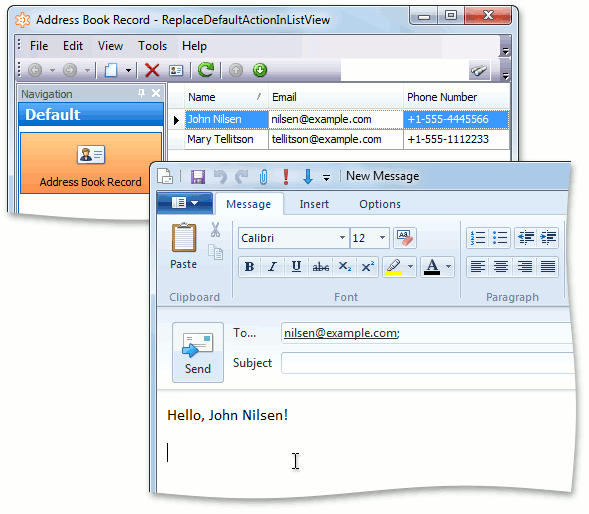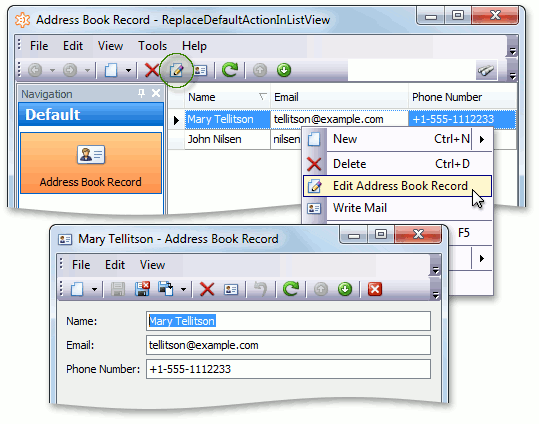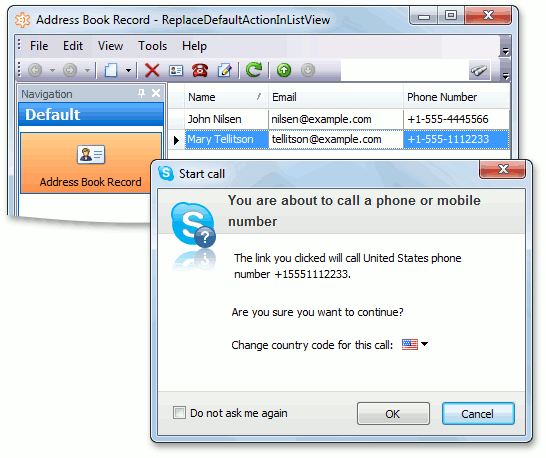How to: Replace a List View's Default Action
- 8 minutes to read
List Views can be accompanied by Actions that represent features specific to these List Views. In addition to these Actions, every List View has an invisible default Simple Action. In Windows Forms applications, this Action is executed when pressing the ENTER key or double-clicking a selected object. In ASP.NET Web Forms and ASP.NET Core Blazor applications, this Action is executed when an object is clicked. This Action is specified by the ListViewProcessCurrentObjectController‘s ListViewProcessCurrentObjectController.ProcessCurrentObjectAction property. You can replace this Action with a custom Simple Action. This topic demonstrates how to do this.
Set a Custom Action as Default
Assume you have the following AddressBookRecord persistent class.
[DefaultClassOptions,ImageName("BO_Contact")]
public class AddressBookRecord : BaseObject {
public virtual string Name { get; set; }
public virtual string Email { get; set; }
public virtual string PhoneNumber { get; set; }
}
// Make sure that you use options.UseChangeTrackingProxies() in your DbContext settings.
Let us consider the WriteMailController View Controller that provides the WriteMail Action for AddressBookRecord objects. This Action invokes the program that is associated with the MailTo protocol on an end-user’s computer.
Note
ASP.NET Core Blazor applications do not allow you to start system processes, but you can use this approach to execute another Action.
using System.Diagnostics;
// ...
public class WriteMailController : ViewController {
private SimpleAction writeMailAction;
public WriteMailController() {
TargetObjectType = typeof(AddressBookRecord);
writeMailAction = new SimpleAction(this, "WriteMail", PredefinedCategory.Edit);
writeMailAction.ToolTip = "Write e-mail to the selected address book record";
writeMailAction.SelectionDependencyType = SelectionDependencyType.RequireSingleObject;
writeMailAction.ImageName = "BO_Contact";
writeMailAction.Execute += writeMailAction_Execute;
}
void writeMailAction_Execute(object sender, SimpleActionExecuteEventArgs e) {
AddressBookRecord record = (AddressBookRecord)e.CurrentObject;
string startInfo = String.Format(
"mailto:{0}?body=Hello, {1}!%0A%0A", record.Email, record.Name);
Process.Start(startInfo);
}
}
By default, the Action specified by the ProcessCurrentObjectAction property of the ListViewProcessCurrentObjectController invokes a Detail View with the clicked object (the ListViewShowObject Action is specified by default). However, the ListViewProcessCurrentObjectController exposes the ListViewProcessCurrentObjectController.CustomProcessSelectedItem event, which you can handle to replace the default Action. The code below demonstrates how to handle this event in WriteMailController to execute a WriteMail Action instead of ListViewShowObject. Subscribe to the CustomProcessSelectedItem event in the overridden OnActivated method. In the event handler, execute the WriteMail Action by invoking the SimpleAction.DoExecute method.
using DevExpress.ExpressApp.SystemModule;
// ...
public class WriteMailController : ViewController {
// ...
private ListViewProcessCurrentObjectController processCurrentObjectController;
protected override void OnActivated() {
base.OnActivated();
processCurrentObjectController =
Frame.GetController<ListViewProcessCurrentObjectController>();
if (processCurrentObjectController != null) {
processCurrentObjectController.CustomProcessSelectedItem +=
processCurrentObjectController_CustomProcessSelectedItem;
}
}
private void processCurrentObjectController_CustomProcessSelectedItem(
object sender, CustomProcessListViewSelectedItemEventArgs e) {
e.Handled = true;
writeMailAction.DoExecute();
}
protected override void OnDeactivated() {
if (processCurrentObjectController != null) {
processCurrentObjectController.CustomProcessSelectedItem -=
processCurrentObjectController_CustomProcessSelectedItem;
}
base.OnDeactivated();
}
}
The following image illustrates that the WriteMail action is executed when clicking a record in the AddressBookRecord objects’ List View.

You may notice that now there is no option to invoke a Detail View to edit a record. You can add to following Controller to fix this.
using DevExpress.ExpressApp.SystemModule;
// ...
public class EditAddressBookRecordController : ViewController<ListView> {
public EditAddressBookRecordController() {
TargetObjectType = typeof(AddressBookRecord);
SimpleAction editAddressBookRecordAction =
new SimpleAction(this, "EditAddressBookRecord", PredefinedCategory.Edit);
editAddressBookRecordAction.ImageName = "Action_Edit";
editAddressBookRecordAction.SelectionDependencyType =
SelectionDependencyType.RequireSingleObject;
editAddressBookRecordAction.Execute += editAddressBookRecordAction_Execute;
}
void editAddressBookRecordAction_Execute(object sender, SimpleActionExecuteEventArgs e) {
ListViewProcessCurrentObjectController.ShowObject(
e.CurrentObject, e.ShowViewParameters, Application, Frame, View);
}
}

Note
Such a controller is required for Windows Forms and ASP.NET Core Blazor applications only, as the WebModificationsController.EditAction Action is available in ASP.NET Web Forms applications.
To leave an option to replace the WriteMail Action in another Controller, you can expose this action via a public property.
public class WriteMailController : ViewController {
// ...
public SimpleAction DefaultListViewAction {
get { return writeMailAction; }
set { writeMailAction = value; }
}
}
Proceed to the next section of this topic to see how this property can be used.
Replace a Custom Default Action
Consider the following PhoneCallController View Controller than provides the PhoneCall Action. This action initiates dialing PhoneNumber of the current AddressBookRecord object in Skype.
public class PhoneCallController : ViewController {
private SimpleAction phoneCallAction;
public PhoneCallController() {
TargetObjectType = typeof(AddressBookRecord);
phoneCallAction = new SimpleAction(this, "PhoneCall", PredefinedCategory.Edit);
phoneCallAction.ToolTip = "Call the current record via Skype";
phoneCallAction.ImageName = "BO_Phone";
phoneCallAction.SelectionDependencyType = SelectionDependencyType.RequireSingleObject;
phoneCallAction.Execute += skypeCallAction_Execute;
}
void skypeCallAction_Execute(object sender, SimpleActionExecuteEventArgs e) {
Process.Start("skype:" + ((AddressBookRecord)e.CurrentObject).PhoneNumber);
}
protected override void OnActivated() {
base.OnActivated();
View.CurrentObjectChanged += View_CurrentObjectChanged;
}
void View_CurrentObjectChanged(object sender, EventArgs e) {
phoneCallAction.Enabled.SetItemValue("PhoneIsSpecified",
!String.IsNullOrEmpty(((AddressBookRecord)View.CurrentObject).PhoneNumber));
}
}
Note
ASP.NET Core Blazor applications do not allow you to start system processes, but you can use this approach to execute another Action.
The List View’s default Action provided by the custom WriteMailController Controller can be replaced with another Action, if it is exposed via a public property. To replace the WriteMail action with PhoneCall, add the following code to the PhoneCallController class’ OnActivated method.
protected override void OnActivated() {
// ...
WriteMailController writeMailController = Frame.GetController<WriteMailController>();
if (writeMailController != null)
writeMailController.DefaultListViewAction = phoneCallAction;
}
The following image illustrates that the PhoneCall action is executed when clicking a record in the AddressBookRecord objects’ List View.

Subscribing to the ListViewProcessCurrentObjectController‘s CustomProcessSelectedItem event, as demonstrated at the beginning of this topic is not a recommended, since there is the possibility that the PhoneCallController Controller will be activated after WriteMailController, and so the WriteMail Action will remain default.
Note
An example provided in this topic is Windows Forms specific just because Actions that start external programs use the Process.Start method. However, the main concept illustrated here in platform-independent - you can access the ListViewProcessCurrentObjectController Controller from ASP.NET Web Forms-specific Controllers in the same manner.